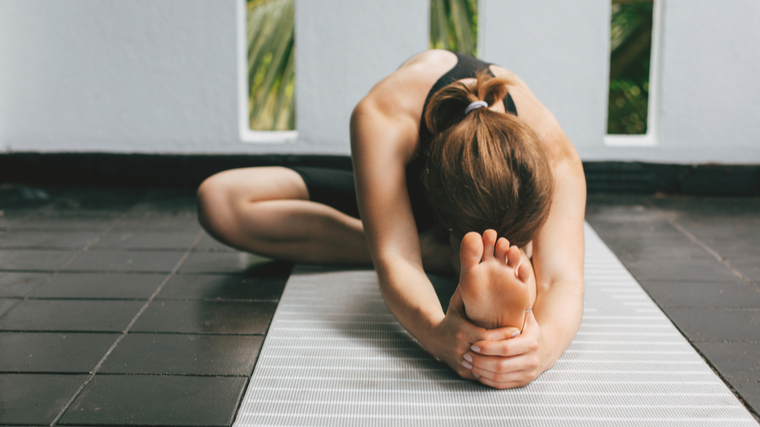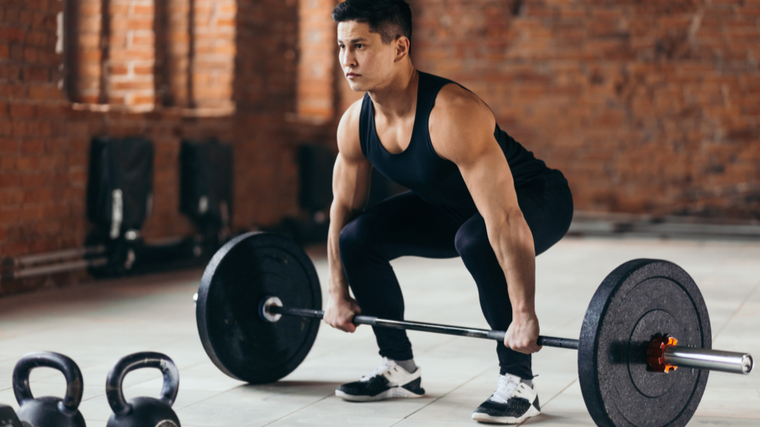If your goal is to build total-body strength, the deadlift deserves to be your bread and butter. A deadlift is a pull from the floor to the hip, and, perhaps most importantly, allows you to work with monstrous amounts of weight relative to many other strength lifts. In both powerlifting and weightlifting, athletes train the deadlift for the universally-recognized purpose of getting truly strong.
The right warm-up can set you up for success on the platform before you ever load up your barbell. For the deadlift in particular, there are some steps you can take to prime your body for picture-perfect lifting and energy utilization.
Here are five components of a proper warm-up that you need to have locked down if you want a high-caliber deadlift. Follow them and you’ll be pulling a new personal record in no time.
The Best Deadlift Warm-Up
Soft Tissue Work
Before all else, you should start your deadlift warmup with some soft tissue work to check in on how your body is feeling. Soft tissue work is a means of addressing any tight or restricted areas in your muscles or joints through techniques such as myofascial release or light stretching.
The tension, knots, or trigger points in your muscles tend to be the most visible and severe when your body is “cold” prior to any physical exercise. Lightly touching up on any painful areas can ensure you move fluidly through the rest of your warm-up.
How to Do Soft Tissue Work
There are plenty of ways to perform self-myofascial release as a form of soft tissue work. You can even begin with some gentle, static stretches such as a child’s pose or the seated forward fold to identify tight or triggering areas in your spine, hips, or legs.
If available, a foam roller and/or massage ball will be a valuable tool here. Gradually apply targeted pressure to the designated muscles to warm and relax them. For the deadlift, areas such as your quads, hamstrings, glutes, and lats should be your primary focus.
Benefits of Soft Tissue Work
- Soft tissue work stimulates blood flow to the working muscles.
- Identifies acute knots or tightness in the body.
- Helps you prepare to utilize your full range of motion.
Light Cardio
Your body performs best when your muscles are warm. When deadlifting, you need to work harder than usual to produce power and move weight. You’ll find it nearly impossible to get a personal record deadlift off the ground if your body is locked up or ice cold. You need to increase your core temperature and flush your tissues with blood to perform well.
Taking your muscle temperature up increases both your force output potential and the rate at which your muscles contract. (1) A higher internal temperature — and thus better blood circulation — can comfortably be accomplished by some low-grade cardiovascular activity.
How to Do Light Cardio
Light cardio should raise your heart rate and help you break a sweat. Select an aerobic movement such as walking, jogging, skipping, jumping jacks, etc., or even a combination of a few exercises performed together as a circuit. Anywhere between two and five minutes of low-intensity cardio should have you warmed-up and ready to hit the bar.
You should avoid going to the point of fatiguing yourself through cardio. Deadlifting requires your highest power potential, so you don’t want to gas yourself out at all while you’re still getting ready to lift in the first place.
Benefits of Light Cardio
- It generally improves the feeling and quality of your movement.
- It’s an easy way to begin the progression into intense lifting.
- It helps prevent injury by adjusting your core temperature to exercise.
Dynamic Stretching/Activation
The muscles you use while deadlifting need to be active and alert in for you to perform your best work. Dynamic stretching involves lengthening and shortening the muscle under light tension.
Post-activation potentiation is the property of muscle in which a higher potential for force output becomes available upon activation. Achieving this allows for more precise force production in your lifts, which likely results in slapping more plates on your barbell during your workout.

How to Do Dynamic Stretching/Activation
For the deadlift, you will need to activate your glutes, quads, hips, back, and shoulders. Depending on your specific strengths, certain areas may need more attention than others. For example, you may find that your knees buckle inward while you deadlift. You can address this directly by performing glute bridges with a resistance band for one or two sets to help prime proper movement and get the relevant musculature “turned on.”
Benefits of Dynamic Stretching/Activation
- Isolates the working muscles to make sure they’re working properly.
- It helps your body stay healthy by gradually applying appropriate resistance to your movements.
Back/Shoulder Stability
Even though the deadlift is renowned for producing lower body strength gains, your upper body is also greatly involved in the lift. Your back and shoulders have the important responsibility of maintaining tension through your trunk. In order to lock out a deadlift with proper form, your shoulders and upper back have to be in lock-step with one another.
How to Do Back/Shoulder Stability Work
For upper body stability, focus on creating tension through your posterior chain, especially your back and shoulder area. Select exercises such as rear flye, scapular push-ups, or single-arm rows to target your upper back. Perform these in a sequence to activate your posterior chain and ensure you’re properly stabilized on each and every repetition.
Benefits of Stability Work
- Locks in your thoracic tension for moving heavier weights.
- Helps dial in the finer points of your technique so you can focus on pulling hard.
Practice Reps
The final stage of a good warm-up is a deadlift-specific progression. Just like a baseball player who uses a lighter bat to warm up their swing, strength athletes prepare for big lifts with lighter loads for the purpose of establishing quality movement. After all the great work you’ve done in to prime your body, you’re ready to hit the barbell.
How to Do Practice Reps
Start with an empty barbell and mimic the exact form of your heavy pulls. As you incrementally add weight while approaching your programmed lifts, pretend as though every rep is a maximum-effort attempt. The heavier your working sets are, the more practice reps you’ll need to do to get there.
[Read More: The Best Upper Body Exercises and Workouts]
Your warm-up sets should also have similar rep counts to whatever your working sets are that day. If you’re pulling heavy sets of three, don’t warm up with sets of 10 or more reps. Specificity will help you grease your groove and get into good pulling habits.
Benefits of Practice Reps
- You’re directly preparing to move better on your top sets.
- By starting with lighter weights, you maximize speed and rep quality in your pull.
- Warm-up sets help you acclimate to the heavier work to come.
Sample Deadlift Warm-Up
Explaining the sequence of a proper warm-up is one thing, but you need to put it into practice to reap the benefits. If you want a grab-and-go deadlift warm-up that suits powerlifting, weightlifting, or general exercise, give this one a go.
- Foam Rolling: 5-10 minutes
- Light Jog or Calisthenics Circuit: 3-5 minutes
- Cat-Camel, Single-Leg Glute Bridge, Bird Dog: Perform two rounds of these exercises back-to-back with no rest
- Barbell Upright Row superset Good Morning: 1-2 sets of 8-15 reps each with the empty bar
- Deadlift: 1-2 sets of 3-6 reps with the empty barbell
This warm-up sequence should take between 15 and 25 minutes in total and address the general movement patterns and requisite flexibility for the deadlift.
Differences Between Weightlifting & Powerlifting Deadlifts
All types of strength athletes utilize the deadlift in one form or another. For powerlifters, it is one of their three main competition movements alongside the squat and bench press. In Olympic lifting, the deadlift is considered an accessory movement that helps support and create a strong pull from the floor during the snatch or clean & jerk.
The differences in purpose and application also mean there are some distinctions to acknowledge.
The Goal
Both weightlifters and powerlifters do deadlifts to build strength off the floor. Powerlifters train them because the deadlift itself is one of their athletic goals. As such, powerlifters employ many different grip or setup techniques to lift the heaviest loads possible. In contrast, weightlifters will train their deadlift to build general strength that transfers to the lighter weights they use in their competition exercises.
For a weightlifter to perform a successful clean, they need enough of a strength reserve to get the bar moving quickly. That’s where an exercise like the clean deadlift comes in.
The Setup
You can set up your lift in different ways, such as varying your grip or stance. As a powerlifter, you want to maximize your leverages and assume whatever posture allows you to lift the most weight safely and effectively.

When practicing deadlifts for weightlifting, you should set up your deadlift in the same way that you would to perform a snatch or clean. The snatch or clean deadlift should move through the exact same positions you’d hit in the performance of the movements themselves to ensure maximum carryover.
The Technique
In powerlifting, specific techniques are used for the most advantageous pull from the floor. For example, in the conventional style, your shins start vertically and your knees drift over the bar, to ensure it moves in a straight line close to your body. The sumo deadlift takes your legs out of the way entirely via a very wide and externally-rotated stance.
Benefits of the Deadlift
The strength you stand to gain from deadlifting is unparalleled. Understanding how the lift benefits you will help you apply it to your training more appropriately.
Lower Body Strength
Your legs perform a ton of the work in a deadlift. The high force output from your glutes, hamstrings, and lower back allows you to move high amounts of weight. Few exercises take your lower body musculature through a full range of contractile motion under such extreme loads, making the deadlift exceptional at helping you gain strength.
Posterior Chain Development
The deadlift requires your posterior chain to be rigid and stable through your lift. Holding tension against weight in the deadlift forces your lower back, glutes, and hamstrings to work synchronously. This not only brings with it some welcome benefits to posture and balance, but also makes deadlifting a great way to pack on more muscle.
Improved Athleticism
Your deadlift requires high force production, which trains your Type-II fast twitch muscle fibers. These fibers are responsible for producing maximum power, especially in heavy lifts. The power production gained from deadlifting will translate to other athletic movements such as throwing or sprinting, making you a more effective athlete on the court or field.
Wrapping Up
The deadlift is the universal training tool. It can be both accessible to newcomers looking to begin their lifting journey and a means of tugging on world-record weights. However, with great power potential comes a great responsibility to set yourself up for success. As the saying goes, if you fail to prepare you prepare to fail.
You need to warm-up properly if you want to be a proficient puller. Taking a few extra minutes at the onset of your training session to go through five or six precursors can ensure that your entire workout operates smoothly and successfully. It’ll pay off in the long run in more ways than you think.
References
1. Racinais, S., Cocking, S., & Périard, J. D. (2017). Sports and environmental temperature: From warming-up to heating-up. Temperature (Austin, Tex.), 4(3), 227–257.
Featured Image: Nikola Spasenoski / Shutterstock